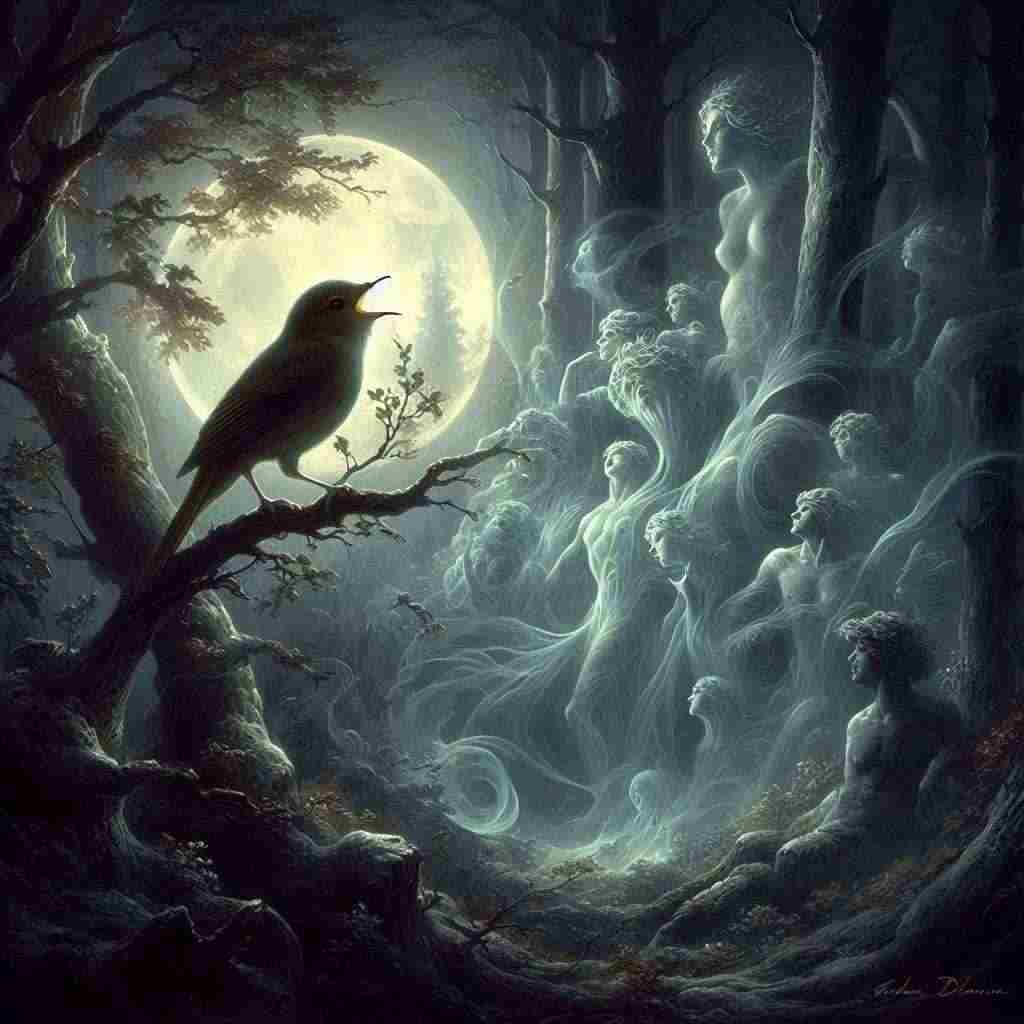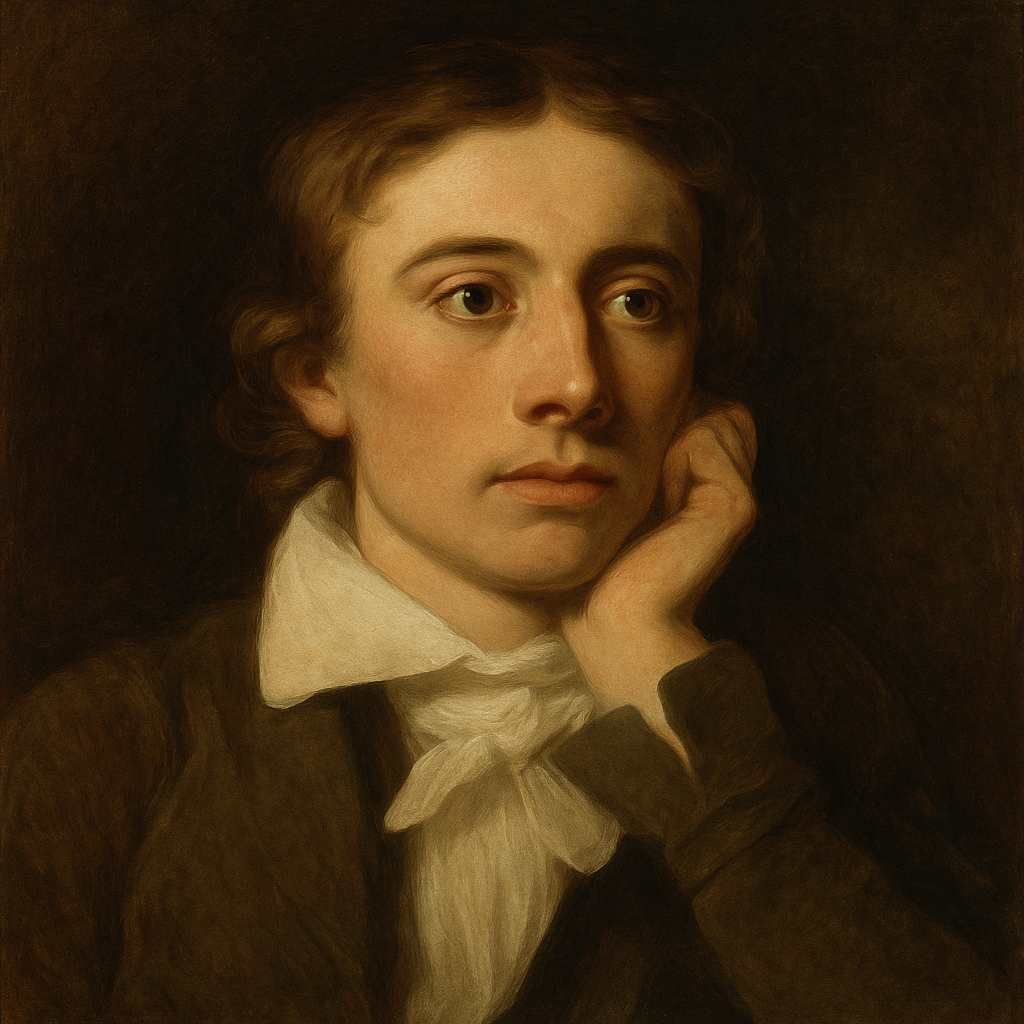Ode to a Nightingale
John Keats
1795 to 1821

My heart aches, and a drowsy numbness pains
My sense, as though of hemlock I had drunk,
Or emptied some dull opiate to the drains
One minute past, and Lethe-wards had sunk:
'Tis not through envy of thy happy lot,
But being too happy in thine happiness, -
That thou, light-winged Dryad of the trees
In some melodious plot
Of beechen green, and shadows numberless,
Singest of summer in full-throated ease.
O, for a draught of vintage! that hath been
Cool'd a long age in the deep-delved earth,
Tasting of Flora and the country green,
Dance, and Provencal song, and sunburnt mirth!
O for a beaker full of the warm South,
Full of the true, the blushful Hippocrene,
With beaded bubbles winking at the brim,
And purple-stained mouth;
That I might drink, and leave the world unseen,
And with thee fade away into the forest dim:
Fade far away, dissolve, and quite forget
What thou among the leaves hast never known,
The weariness, the fever, and the fret
Here, where men sit and hear each other groan;
Where palsy shakes a few, sad, last gray hairs,
Where youth grows pale, and spectre-thin, and dies;
Where but to think is to be full of sorrow
And leaden-eyed despairs,
Where Beauty cannot keep her lustrous eyes,
Or new Love pine at them beyond to-morrow.
Away! away! for I will fly to thee,
Not charioted by Bacchus and his pards,
But on the viewless wings of Poesy,
Though the dull brain perplexes and retards:
Already with thee! tender is the night,
And haply the Queen-Moon is on her throne,
Cluster'd around by all her starry Fays;
But here there is no light,
Save what from heaven is with the breezes blown
Through verdurous glooms and winding mossy ways.
I cannot see what flowers are at my feet,
Nor what soft incense hangs upon the boughs,
But, in embalmed darkness, guess each sweet
Wherewith the seasonable month endows
The grass, the thicket, and the fruit-tree wild;
White hawthorn, and the pastoral eglantine;
Fast fading violets cover'd up in leaves;
And mid-May's eldest child,
The coming musk-rose, full of dewy wine,
The murmurous haunt of flies on summer eves.
Darkling I listen; and, for many a time
I have been half in love with easeful Death,
Call'd him soft names in many a mused rhyme,
To take into the air my quiet breath;
Now more than ever seems it rich to die,
To cease upon the midnight with no pain,
While thou art pouring forth thy soul abroad
In such an ecstasy!
Still wouldst thou sing, and I have ears in vain -
To thy high requiem become a sod.
Thou wast not born for death, immortal Bird!
No hungry generations tread thee down;
The voice I hear this passing night was heard
In ancient days by emperor and clown:
Perhaps the self-same song that found a path
Through the sad heart of Ruth, when, sick for home,
She stood in tears amid the alien corn;
The same that oft-times hath
Charm'd magic casements, opening on the foam
Of perilous seas, in faery lands forlorn.
Forlorn! the very word is like a bell
To toll me back from thee to my sole self!
Adieu! the fancy cannot cheat so well
As she is fam'd to do, deceiving elf.
Adieu! adieu! thy plaintive anthem fades
Past the near meadows, over the still stream,
Up the hill-side; and now 'tis buried deep
In the next valley-glades:
Was it a vision, or a waking dream?
Fled is that music: - Do I wake or sleep?
John Keats's Ode to a Nightingale
John Keats's "Ode to a Nightingale" is a masterpiece of Romantic poetry, showcasing the poet's profound engagement with themes of mortality, the transience of human existence, and the power of imagination. Composed in 1819, during a period of intense creativity for Keats, this ode reflects his deep emotional and intellectual struggles, as well as his extraordinary ability to transform personal experience into universal art.
The poem opens with a striking declaration of the speaker's emotional state: "My heart aches, and a drowsy numbness pains / My sense." This immediate plunge into sensation and feeling is characteristic of Keats's style, emphasizing the visceral nature of the poetic experience. The comparison to the effects of "hemlock" and a "dull opiate" introduces the poem's central tension between consciousness and oblivion, a conflict that will be explored throughout the eight stanzas.
The nightingale, the ostensible subject of the ode, serves as a complex symbol. On one level, it represents the beauty and permanence of nature, contrasting sharply with the poet's awareness of human suffering and mortality. The bird's song, described as being sung with "full-throated ease," evokes a sense of effortless creativity that the poet both admires and envies. This admiration is tinged with melancholy, as the speaker recognizes that the bird's carefree existence is fundamentally different from his own human condition.
Keats employs rich sensory imagery throughout the poem, engaging all five senses to create a vivid, almost intoxicating atmosphere. The second stanza's yearning for "a draught of vintage" is particularly evocative, blending tastes, smells, and visual imagery to convey a desire for escape and transcendence. This sensual language serves to heighten the contrast between the speaker's earthbound reality and the ethereal world of the nightingale.
The third stanza marks a shift in tone, as the speaker confronts the harsh realities of human existence. The litany of human ills - "The weariness, the fever, and the fret" - creates a stark contrast with the nightingale's carefree song. This juxtaposition underscores one of the poem's central themes: the inevitable suffering inherent in human consciousness and the desire to escape it.
The fourth and fifth stanzas describe the speaker's imaginative flight to join the nightingale. Keats's use of negative capability is evident here, as the poet embraces uncertainty and mystery. The darkness of the forest becomes a metaphor for the unknown, with the speaker relying on senses other than sight to experience his surroundings. This sensory deprivation paradoxically leads to a heightened awareness, illustrating Keats's belief in the power of imagination to transcend physical limitations.
In the sixth stanza, Keats introduces the theme of death, describing it as "easeful" and even desirable. This fascination with mortality is a recurring motif in Keats's work, reflecting both his personal experiences with loss and his broader philosophical concerns. The speaker's contemplation of death at the height of the nightingale's song creates a powerful tension between the transience of human life and the seeming permanence of natural beauty.
The penultimate stanza expands the scope of the poem, connecting the nightingale's song to a broader historical and mythological context. By invoking figures from the Bible and folklore, Keats suggests that the bird's song transcends time and culture, representing a universal aspect of human experience. This idea of the nightingale as an "immortal Bird" contrasts sharply with the poet's acute awareness of his own mortality.
The final stanza brings the speaker back to reality, with the fading of the nightingale's song serving as a metaphor for the fleeting nature of artistic inspiration and transcendent experiences. The poem's closing question - "Do I wake or sleep?" - leaves the reader with a sense of ambiguity, blurring the lines between reality and imagination, waking and dreaming.
Throughout "Ode to a Nightingale," Keats demonstrates his mastery of the ode form, using its structure to explore complex emotional and philosophical ideas. The regular rhyme scheme and ten-line stanzas provide a framework for the poet's meandering thoughts, while the varying line lengths allow for moments of both intense emotion and quiet reflection.
In conclusion, "Ode to a Nightingale" stands as a testament to Keats's poetic genius, encapsulating many of the central concerns of Romantic poetry. Through its exploration of the tensions between mortality and immortality, consciousness and oblivion, and reality and imagination, the poem offers a profound meditation on the human condition. Keats's vivid imagery, emotional depth, and philosophical insights continue to resonate with readers, cementing the poem's place as one of the greatest works in the English language.
This text was generated by AI and is for reference only. Learn more
Want to join the discussion? Reopen or create a unique username to comment. No personal details required!



Comments
No comments yet. Be the first to comment!